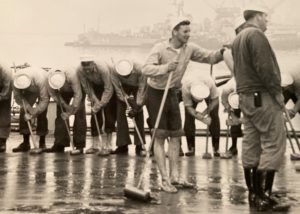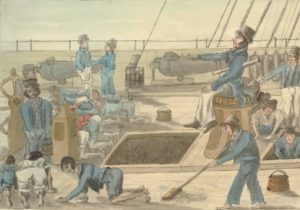When I was a petty officer aboard USS Los Angeles (CA-135) one of my duties was to put a little fear in the hearts of new guys in my division: stay squared away or else. I did that by introducing them to an old Navy tradition.
The Executive Division, my division, got the smartest of the seamen and firemen apprentices coming aboard ship right out of boot camp, the ones who had a year or two of college or who had high test scores. That wasn’t exactly fair, but that’s the way it was — the ship’s personnel office was part of our division.
And if a new guy didn’t work out, we got rid of him.
On these special teaching mornings I would have the watch wake me real early. Then I’d tell the new guy to get up, get dressed, and come with me. We’d go to the compartment where I worked, right below the main deck, and I’d make coffee, light up a Crook cigar, and wait.
There was no talk. I’d just let him sit there, wondering what was going on. When I heard a low rumbling coming from the main deck, and sailors counting, “A-one, two, three, four, five, six, seven, eight. A-one, two…” I’d tell the new man, “Let’s go.”

We would climbed the ladder to the main deck and there before him would be a pretty remarkable sight –scores of sailors, pants legs rolled up, holystoning the deck, like American sailors had done for almost 200 years.
The Los Angeles had teak decks and they had to be kept spotless — we were a flag ship, we had an admiral on board. Holystoning was the best way to do that.
A holystone is a piece of soft sandstone, about the size of a brick, with a hole in the middle that didn’t go all the way through. Sailors stuck what looked just like a broom handle into the hole, bent over, and pushed and pulled the holystone back and forth, scrubbing and whitening the LA’s decks.
There would be six or eight sailors in a line here, four in a line over there, 15 working on a wider spot over yonder. All of them would be chanting, “A-one, two, three…” When the count got to eight they would move forward four inches and started again.
Saliors assigned to deck divisions holystoned in good weather and bad and always in the early morning hours, before breakfast.
We would stand there a few minutes, watching in silence. And then I would tell the new guy, “If you [mess up] we are going to send you to the deck. Now let’s go back to sleep.”
NOTE from the USSConstitution.org web site:
“In the 18th and 19th centuries, Constitution‘s sailors began their day by cleaning the ship with the unwelcome task of holystoning the decks. A hand  pump wet the deck with seawater, and men with buckets cast sand over the planks. The watch then scoured away the previous day’s dirt and grime with soft white stones and stiff brushes. Some believe “holystoning” got its name because scrubbing sailors looked as if they were kneeling in prayer. This was the “most disagreeable duty in the ship,” wrote Samuel Leech, a sailor aboard during the War of 1812, especially “on cold, frosty mornings.”
pump wet the deck with seawater, and men with buckets cast sand over the planks. The watch then scoured away the previous day’s dirt and grime with soft white stones and stiff brushes. Some believe “holystoning” got its name because scrubbing sailors looked as if they were kneeling in prayer. This was the “most disagreeable duty in the ship,” wrote Samuel Leech, a sailor aboard during the War of 1812, especially “on cold, frosty mornings.”
Coming Friday: If I Were The Boss Of Everything